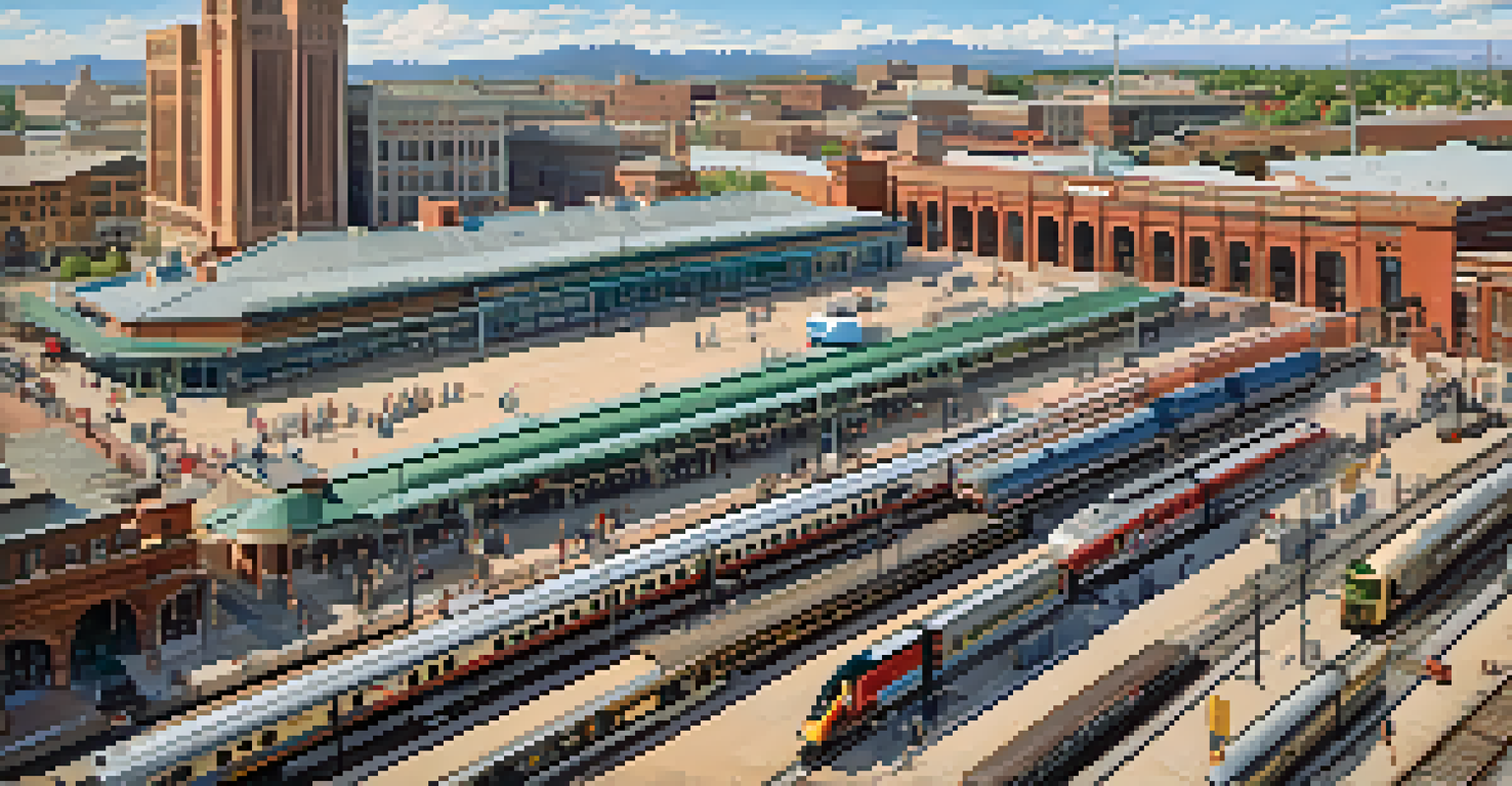The Role of Railroads in Colorado's Transportation Network

A Historical Perspective on Colorado's Railroads
Railroads have played a pivotal role in Colorado's development since the 19th century. The arrival of the first train in 1870 marked a significant turning point, connecting remote mining towns to larger cities and enabling economic growth. This historical foundation laid the groundwork for a robust transportation network that continues to evolve.
The railroad is a great equalizer, bringing people together and connecting communities, no matter where they are from.
As settlers moved westward, railroads facilitated not just the movement of goods but also people, fostering communities along their routes. The Denver & Rio Grande Railroad, for instance, was instrumental in opening up the scenic Rocky Mountains for tourism, showcasing Colorado's stunning landscapes. This dual function of commerce and leisure established railroads as a vital artery for the state's growth.
Today, many of these historical lines have been preserved and serve both functional and recreational purposes. Understanding this rich history is crucial for appreciating the railroads' ongoing impact on Colorado's transportation landscape. They are not just relics of the past; they are integral to the present-day economy and infrastructure.
Economic Impact of Railroads in Colorado
The economic significance of railroads in Colorado cannot be overstated. They facilitate the transport of essential goods, including agricultural products, minerals, and manufactured items, connecting producers to markets efficiently. This logistical capability is vital for the state's economy, supporting jobs and fostering growth across various sectors.

Moreover, railroads help reduce congestion on the highways, offering a greener alternative for transporting large quantities of freight. This efficiency not only benefits businesses but also reduces overall transportation costs, making Colorado a more attractive place for new industries. The synergy between rail and road transport enhances the overall economic landscape.
Railroads Fuel Colorado's Economy
Railroads are crucial for transporting goods, reducing congestion, and creating jobs, significantly boosting Colorado's economic landscape.
Investments in rail infrastructure also create jobs, both in the short term during construction and long-term in maintenance and operations. As Colorado continues to grow, the expansion and modernization of its rail network will play a key role in sustaining economic vitality and ensuring competitiveness in the regional market.
Environmental Benefits of Rail Transportation
Railroads offer significant environmental advantages compared to road transport. Trains can move a considerable amount of freight using less fuel per ton-mile than trucks, which helps to reduce greenhouse gas emissions. This efficiency contributes to Colorado's broader sustainability goals, particularly as the state seeks to address climate change and promote greener practices.
Railroads are a vital artery for economic growth, helping to transport goods and connect people across vast distances.
Additionally, by alleviating traffic congestion on highways, railroads help to improve air quality in urban areas. Fewer vehicles on the road mean less pollution and a healthier environment for residents. This is especially important in cities like Denver, where air quality has been a growing concern.
The shift towards rail transport is not only about environmental stewardship but also about setting a precedent for future transportation solutions. As technology advances, increasing the use of electric and hybrid trains could further enhance the ecological benefits of railroads, paving the way for a more sustainable transportation network in Colorado.
Passenger Rail Services in Colorado
While freight services dominate, passenger rail also plays a crucial role in Colorado's transportation network. Amtrak's California Zephyr, for instance, offers scenic routes through the Rockies, attracting tourists and providing a convenient travel option for residents. This not only promotes tourism but also helps reduce traffic congestion.
In recent years, there has been a renewed interest in expanding passenger rail services, including commuter lines in the Denver metropolitan area. These initiatives aim to provide a reliable alternative to driving, supporting the state's growing population and urban development. Increased ridership can lead to less road wear, lower maintenance costs, and a reduced environmental footprint.
Environmental Benefits of Rail Travel
Trains offer a greener alternative to trucks, helping to reduce greenhouse gas emissions and improve air quality in urban areas.
Community engagement and funding will be vital in the expansion of passenger services. As more people recognize the convenience and benefits of rail travel, collaboration between local governments, transit authorities, and residents will be essential in shaping the future of passenger rail in Colorado.
Challenges Facing Colorado's Rail Network
Despite the benefits, Colorado's rail network faces several challenges that could hinder its growth and efficiency. Aging infrastructure is a significant concern, as many lines require upgrades to meet modern safety and operational standards. Investing in these upgrades is crucial to ensure the reliability of rail services for both freight and passengers.
Additionally, competition from other forms of transportation, particularly trucking and air travel, poses a challenge. As these alternatives grow, railroads must find ways to remain competitive, which may involve innovative scheduling, pricing strategies, and enhanced services. Balancing these competing interests is key to maintaining a robust transportation network.
Lastly, environmental regulations and community opposition to rail expansions can slow progress. Engaging with stakeholders and addressing concerns is essential for developing a rail network that meets the needs of all Coloradans while adhering to environmental standards.
Future Developments in Colorado's Rail Transportation
Looking ahead, the future of rail transportation in Colorado appears promising, with various development projects on the horizon. Initiatives aimed at expanding freight capabilities and improving passenger services are being explored, signaling a commitment to enhancing the overall transportation infrastructure. These developments may also include the introduction of high-speed rail, which could revolutionize travel within the state.
Funding and partnerships will play a crucial role in realizing these ambitious plans. By collaborating with federal, state, and local agencies, as well as private sector partners, Colorado can secure the resources needed to modernize its rail network. This collaborative approach is essential for overcoming the challenges that lie ahead.
Cultural Heritage of Railroads
Railroads are deeply embedded in Colorado's history, symbolizing adventure and community, while fostering local pride through cultural events.
As technology continues to advance, incorporating smart systems for scheduling and logistics may also enhance the efficiency of rail operations. Embracing innovation will not only benefit the economy but also ensure that Colorado's railroads remain a vital part of the transportation landscape for generations to come.
The Community and Cultural Significance of Railroads
Beyond economics and environmental considerations, railroads hold a deep cultural significance in Colorado. They are woven into the fabric of the state's history, symbolizing exploration, adventure, and the pioneering spirit. Towns that sprang up along the rail lines often boast rich stories and heritage that continue to attract visitors today.
Local events, such as train festivals and heritage days, celebrate this connection, fostering community pride and awareness. These gatherings not only honor the past but also engage residents in the ongoing narrative of railroads in their lives. Such cultural appreciation helps to ensure that the legacy of railroads is not forgotten.

Furthermore, railroads often serve as public spaces for connection and community interaction. The stations themselves can become gathering places, linking people not just to their destinations but also to each other. This social aspect of rail travel enriches the overall experience, making it more than just a means of transportation.